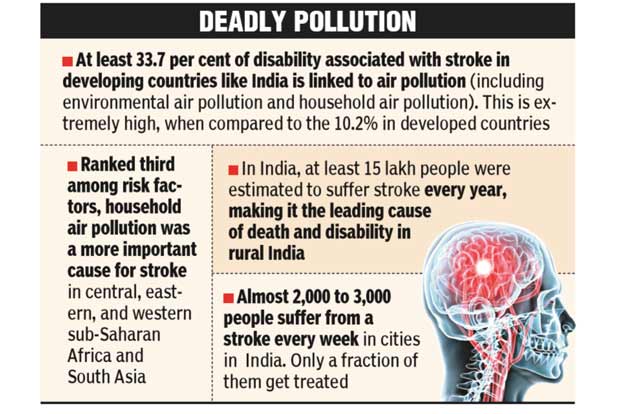Begin typing your search...
Air pollution behind 30% of global stroke cases: Study
A new study published in Lancet Neurology has attributed 30 per cent of the global stroke burden to air pollution. The burden is exceptionally high among developing countries like India, where both traditional and non-traditional risk factors are equally rampant.

Chennai
Experts say that the study is an eye opener as air pollution is modifiable, like sedentary lifestyle or improper diet.
Air pollution, which constitutes both environmental and household pollution, has emerged as one of the leading causes of stroke across the world that accounted for 30 per cent of the cases as a risk factor, according to the study published in Lancet Neurology.
It looked into data across 188 countries from 1990-2013, revealed that 29·2% of the global burden of stroke was attributed to air pollution.
U Meenakshisundaram, professor and head, Neurology, Sri Ramachandra University, said that while the study has established an already known finding, it was high time air pollution was addressed.
“A decade ago, a Korean study linked air pollution to ischemic stroke. But this study makes an interesting observation that in India, it is household air pollution, while in China it is environmental pollution. We need to focus on more ventilated homes to address the risk factor,” Dr Meenakshisundaram says.
Sathish Kumar V, neurologist-stroke specialist, Fortis Malar Hospital, said that the revelations call for a closer study into emissions from household appliances.
“With this study, one must understand that emissions from vehicles have always been a known pollutant, but we are yet to ascertain what kind of radiation and pollutants are emitted from household appliances,” Dr Sathish Kumar V added.
The study also revealed that globally, 90·5% of the stroke burden could be attributed to the modifiable risk factors analysed, including 74·2% due to behavioural factors (smoking, poor diet, and low physical activity, apart from highlighting disabilities as a result of stroke, including paralysis).
Halprashanth DS, Head of Neurology, Global Hospitals, said that in India the onset was much before, when compared to Western countries. “In the US, if a 70-year-old is prone to having a stroke, in India even a 36-year-old is predisposed to it. The factors are largely modifiable. Among the 15 lakh cases, 50 per cent die before a year. Stroke is also a highly disabling condition,” Dr Halprashanth DS said.
He also added that another area to focus on was timely treatment.
“There are treatment options that can help reverse the condition by 50 per cent,” Dr Halprashanth DS said.
Visit news.dtnext.in to explore our interactive epaper!
Download the DT Next app for more exciting features!
Click here for iOS
Click here for Android
Next Story



